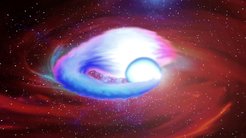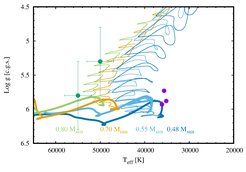Peculiar white dwarf mergers
Two types of hot, blue and dense stars that show peculiar characteristics in their composition and vibrations have posed a challenge to astrophysicists for more than a decade. A team of scientists from MPA and La Plata in Argentina, has now been able to explain both types as a product of very similar merger events. In particular, the scientists think that the peculiar hot and blue stars are formed by the merger of two white dwarfs.
The majority of stars in the Universe have atmospheres composed principally by hydrogen and, in smaller amounts, by helium. Most of the hot, blue, light-but-dense stars, however, generally do not show their helium. The gravity on their surface is sufficiently high so that the slightly heavier helium sinks below the hydrogen. Many of these stars pulsate, or vibrate like music instruments – but instead of producing sound, they produce peculiar light patterns. These light patterns allow us to study their internal structure and to understand the origin of their vibrations.

Two types of hot, blue and dense stars, however, constitute a challenge for scientists: Only three stars are known of the first type and they have presented a puzzle to astronomers since the discovery of the first one, back in 2011. The atmospheres of these stars is a mixture of helium and hydrogen, while we expect this kind of stars to have only hydrogen on their surfaces. In addition, these helium-rich stars are vibrating, very differently from “normal” hot blue stars with atmospheres made of hydrogen. Several possible explanations of why these helium-rich blue stars are pulsating, their internal composition, and their history have been published since 2011 – none of them completely addressing all of these questions. Astronomers of the Universities of Tübingen and Potsdam have recently reported the discovery of another type of peculiar hot blue stars. These stars are covered by carbon and oxygen, a very exotic feature that is even more complicated to explain than the presence of helium in these stars.
While these two classes of hot and blue stars look very different, a group of scientists from MPA and La Plata in Argentina, has been able to explain the weird compositions in both and the vibrations in the helium-rich ones as a product of very similar merger events of two white dwarfs.
A merger event happens when two stars orbiting very closely are attracted by gravitational forces, finally fusing with each other to form a single star. Sometimes such a double star system consists of white dwarfs, small ancient stars, which are the final state of life of stars like our Sun. They are denser than the majority of the stars in the Universe, with a mass of around half the mass of the Sun compressed into a volume similar to the one of Earth. The majority of white dwarfs have a core of carbon and oxygen, surrounded by a mantle of helium, and an outer envelope of hydrogen.

In a merger of two white dwarfs, the less massive star will be disrupted and its material poured on top of the more massive companion. Therefore, if the less massive star is made principally of carbon and oxygen, carbon and oxygen should be observed in the product star after the merger. White dwarfs with carbon-oxygen cores usually have around 0.6 the mass of the Sun, or a bit more. Some of them, however, can be less than the half the mass of our Sun. Interestingly, a merger of such a low-mass carbon-oxygen white dwarf with a slightly more massive one can produce hot, blue, light-but-dense stars.
When the merger product has a low mass (around half of the Sun’s mass), the high gravity on the surface of the star will cause carbon and oxygen to sink, hiding below an atmosphere composed of hydrogen and helium. Still lurking close to the surface, however, the carbon and oxygen can trigger pulsations that look very similar to those of the helium-rich stars that have puzzled astronomers for more than a decade. The astrophysicists have also argued that, for slightly more massive merger products (around 0.8 the mass of the Sun) winds in the atmosphere might stop the sinking process of carbon and oxygen, making the stars look like the recently discovered ones.
Thus, the existence of both types of peculiar hot, blue, light-but-dense stars, including the vibrations presented by the helium-rich ones, can be explained as products of a similar merger history.













